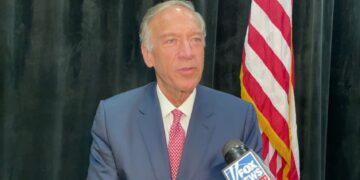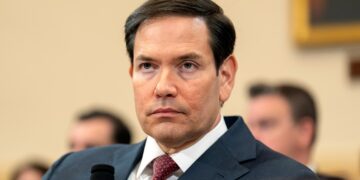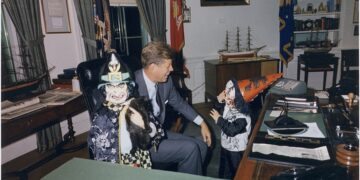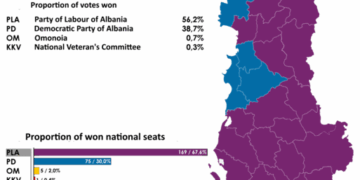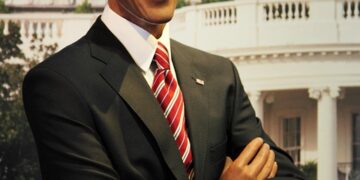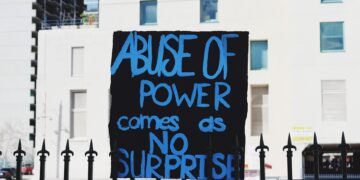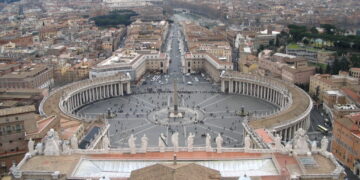UNITED NATIONS — My colleague Alex Newman, a senior editor for The New American, and I were on the ground at the UN Summit of the Future in New York City, September 22-23, 2024. We observed supercharged efforts from the organization to censor journalists, cleanse what they label “information ecosystems,” and bolster taxpayer-funded media. While the censorship of information online is not a new phenomenon, this fanaticism from the UN is indicative of their preparations to ensure a watertight media, acting in lockstep to positively report on present and upcoming UN power grabs.
Censoring True Journalism
On the first day of our on-the-ground coverage of the summit, after acquiring our accredited press passes, Newman and I were immediately directed to what UN security called the “media tent,” a semipermanent white structure located on the north-side garden of UN headquarters. Inside, approximately 10 to 15 large flatscreen televisions were arranged, broadcasting UN-TV — a livestream of the speakers presenting to the General Assembly and available to the public on YouTube. Journalists were asked repeatedly to stay near and within the tent. Coffee and snacks were sold therein, so there was no reason to leave, and virtually every journalist in attendance never did.
Seeing that there were no scoops to obtain and no interviews to conduct in a stuffy tent with journalists from nearly every major country on earth — except America, which we will address later — Newman and I set out to scour the premises to conduct real journalism, interviewing UN movers and shakers in their natural habitats, unscripted.
Very quickly, we recognized that to get near meeting chambers, offices, and hallways where officials would appear, we needed to obtain an escort through the UN Media Accreditation Liaison Unit (MALU). Even with an escort, most areas were strictly prohibited. We were told “Defcon 5” security was in place, and journalism was no exception.
Members of the media were provided with a brief daily summary of the events that would take place during the day. Nearly all the listed events were inaccessible to the press, and more than half were simply quick opportunities to take pictures of foreign leaders upon arrival, with no questions allowed. Locations of the events were poorly labeled, and no maps were provided or displayed throughout the entire UN campus. Newman and I are convinced this was by design to discourage media presence.
Determined to do our jobs despite the hurdles, we decided to hunt down the UN Press Briefing Room, which we discovered was located in room S-237. We obtained a MALU escort, a young 20-something from Hong Kong, who said she was willing to help us find the briefing room.
After bypassing multiple levels of security under her direction, and being passed off from escort to escort, we found out we were headed not toward the press briefing room, but to the secure UN office building and the 27th floor.
Somehow, our Communist Chinese escorts, most likely in ignorance, misread “UN Press Briefing Room — S-237” and only absorbed the “2” and the “7,” taking us directly into a high-level security area. The elevator doors opened. We made a turn and encountered UN guards in ceremonial attire posted in the hallway. Their initial confusion at seeing us turned into concern as they began to question our presence after glancing at our credentials, which displayed a large “P” for press.
The armed guards quickly called the elevator and forced us out, as a swarm of UN police observed our gear and every move. The 27th floor, we later found out, was the location where UN Secretary-General António Guterres received presidents, prime ministers, potentates, and dictators for photo-ops and meetings.
Upon arriving back onto the second floor, where we began, we were handed off to an older Communist Chinese escort, who was extraordinarily hostile, questioning how we were able to bypass security and get so far from the media tent. She refused to believe that the younger escort could so foolishly take us behind the curtain.
While telling us off for being journalists during our escorted exit from the building, the senior Chinese UN official took us down a large corridor covered in explicitly Marxist art. One large mural caught my eye: a scene of workers removing the earth’s natural materials, surrounded by ancient-looking characters, dead bodies, and skeletons with machinery protruding in their remains. At the center, men are constructing a new earth, made of steel. And at the top of the new world, a four-armed man is placing the UN seal on the crown of the newly erected earth.
Naturally, I whipped out my camera to photograph the art. I believed then, as I do now, that the painting succinctly depicts the UN’s end goal: to destroy God’s ordained earth and the institutions therein and replace it with a new world made in man’s image.
After snapping two images of the mural, our Chinese escort shouted, “Hey! You’re not allowed to film that! Do not take any pictures!” Unfortunately for her, I had already snagged a few shots, which have been published and received thousands of views.

American Journalists Look the Other Way While Foreign Media Cheers
Perhaps one of the saddest, and most telling, clues that the media is an accomplice to the UN and its globalist agenda was the lack of American media at the Summit of the Future. Newman and I observed only two other U.S. news outlets on site reporting — The Associated Press and a local New York news outlet. The hundreds of other press members were largely from nations such as China, Pakistan, India, and Sweden.
The lack of American media is shocking considering that 193 nations had representatives present, including some of the most controversial presidents, prime ministers, and royalty such as Volodymyr Zelensky, Justin Trudeau, Joe Biden, and Benjamin Netanyahu. One would think that the American news media would swarm the UN to get photographs and interviews while so many leaders were all in one place.
The reality is that if the press in the United States reported on what the UN was up to, the American people would push back and perhaps support efforts to get the United States out of the UN, as The John Birch Society has been advocating for decades. And yet, they are radio silent.
Lapdogs Versus Watchdogs
Alex Newman correctly labels the press at UN events as the “cheerleading section,” and a quick search online for articles “reporting” on the summit proves this label to be accurate. The Associated Press began a report on the summit saying, “The U.N. General Assembly approved a blueprint Sunday to bring the world’s increasingly divided nations together.” An article from Forbes titled “5 Reasons You Should Care About The Summit Of The Future” says, “This event will be a critical step toward a reinvigorated multilateralism that enhances cooperation on critical challenges, addresses the current gaps in global governance and positively impacts our lives.”
We observed no tough questions, and nothing unscripted.
The media even wore the UN’s version of a home jersey, the Sustainable Development Goals pin. At any given time, I could look and see journalists proudly displaying support for the UN’s agenda by wearing the pin.
Ultimately, the media have become the lapdogs of the globalist elite rather than the watchdogs. They sit when they are told, roll over for a treat, and occasionally bark on command, but they never sniff out a story, dig up a scandal, or alert the public of impending danger.
UN Commits to Cleansing “Information Ecosystems”
On day two of our reporting, Newman and I were pleased to discover that breakout sessions were open to the press, a privilege that was previously denied. The first session we attended was titled “Information Integrity and News.”
Moderated by UN Under-Secretary-General for Global Communications Melissa Fleming, three speakers comprised the panel: Jonathan Munro, BBC News global director and deputy CEO; Mira Milosevic, executive director of the Global Fund for Media Development; and Fridah Naliaka Simiyu, 2024 Reham al-Farra memorial journalism fellow.
Fleming said during the panel that we “are swimming in toxic information ecosystems.” Part of the “toxins” in the “ecosystems” are citizen journalists, explained the BBC’s Munro. “I think citizen journalists can be extremely helpful in gathering evidence of what has happened, but they do not very often do much journalism,” he opined. “They are more citizens than journalists.”
According to Fleming, the answer to cleansing the ecosystems that we all “swim in” is to bolster spending for taxpayer-funded media. “What better service for our information environments out there other than the BBC?” Fleming asked.
The Pact for the Future’s Commitment to Control Information
In Objective 3, the UN’s Pact for the Future — which Newman analyzes in the cover story of this issue — articulates the UN’s efforts to cleanse and control “information integrity.”
“We recognize that digital and emerging technologies can facilitate the manipulation of and interference with information in ways that are harmful to societies and individuals, and negatively affect the enjoyment of human rights and fundamental freedoms as well as the attainment of the Sustainable Development Goals,” the adopted agreement states.
This push is in large part a reaction to the Covid-19 crisis, and what the World Health Organization (WHO) labeled an “infodemic.” After a few months of the coronavirus craze, Americans began to find voices that dissented from the “experts,” such as Dr. Anthony Fauci and those at the National Institutes of Health, WHO, and Centers for Disease Control and Prevention.
Platforms such as Rumble, Truth Social, and now Elon Musk’s X, alongside publications such as The New American, elevated the voices of Dr. Robert Malone, Dr. Peter McCullough, and others who sounded the alarm about the harms of lockdowns and untested vaccines.
From what we observed on the ground, the UN is desperate to make sure that whenever the next “crisis” arises, the “information ecosystem” will be better prepared to offer the public a government-backed narrative of the situation with no dissenting voices.
According to the pact, the UN will “promote access to relevant, reliable and accurate information in crisis situations, to protect and empower those in vulnerable situations.”
To achieve this, the pact calls on tech and social-media companies to enhance “content moderation” and “recommendation algorithms” to help users make “informed choices.”
This manipulation of the national narrative, either by elevating or censoring various sources of information online through a corrupt merger of state and corporate media power, is in contradiction to the First Amendment of the U.S. Constitution. Americans’ God-given right to free speech is an essential liberty, which the Constitution plainly protects: “Congress shall make no law respecting an establishment of religion, or prohibiting the free exercise thereof; or abridging the freedom of speech, or of the press; or the right of the people peaceably to assemble, and to petition the government for a redress of grievances.”

Advocates for global governance are becoming more vocal in their support of censorship and restrictions on alternative media. John Kerry, former special presidential envoy for climate, recently said the quiet part out loud, voicing his frustration with Americans’ First Amendment-protected rights. “Look, if people go to one source, and the one source they go to is sick and, you know, has an agenda and they’re putting out disinformation, our First Amendment stands as a major block to the ability to just hammer it out of existence,” he stated in September 2024 at the World Economic Forum.
Kerry further explained why this freedom is so prohibitive to global governance: “People go and people self-select where they go for their news and for their information, and then you just get into a vicious cycle. So, it’s really, really hard, much harder to build consensus today than any time in the 45-50 years I’ve been involved in this.”
The UN is determined to eliminate citizens’ ability to do their own research, and is banging the war drums louder than ever before to accomplish that end.

